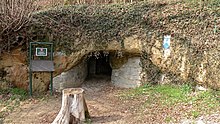| This article includes a list of general references, but it lacks sufficient corresponding inline citations. Please help to improve this article by introducing more precise citations. (April 2018) (Learn how and when to remove this message) |

An erdstall is a type of tunnel found across Europe. They are of unknown origin but are believed to date from the Middle Ages. A variety of purposes have been theorized, including that they were used as escape routes or hiding places, but the most prominent theory is that they served a religious or spiritual purpose.
Etymology
The word Erdstall is derived from the medieval (Middle High German) forms of German Erde (earth) and either Stelle (place) or 'Stollen' ("mineshaft"). There are very few historical references – a document from 1449 names the area above the tunnels as 'auf den erdstelln'.
Alternative regional names are "schratzlloch" (Bavaria), "zwergloch" and "grufen" (Austria), that carry the regional names for dwarfs that folk belief has connected them to.
Construction
Erdstalls are very low and narrow – they have a height of 1.0 to 1.4 metres (3 ft 3 in to 4 ft 7 in) and a maximum width of about 60 centimetres (24 in). Additionally, they feature very tight passages connecting one tunnel to a lower tunnel called a "schlupf" (slip out), which are typically extremely narrow and impassable for some, as crawling under the slip hole, and then standing up to slide the shoulders through, is necessary to crawl into the higher tunnel.
There is only one narrow concealed entry point, with no second exit tunnel as is common with an escape tunnel system. Some tunnel systems feature loop tunnels at the end of a tunnel. Most tunnel systems are no longer than 50 metres (160 ft).
-
 Vertical passage (slip hole)
Vertical passage (slip hole)
-
 Horizontal passage
Horizontal passage
-
 Sitting recess at the end of the tunnel
Sitting recess at the end of the tunnel
-
 Map of the large erdstall in Bad Zell
Map of the large erdstall in Bad Zell
Classification
In his 2000 publication Die Regional-Typisierung der Erdställe, Herbert Wimmer created a rough classification system for varying types of erdstall:
- Type A has a single long gallery with slip passages and short side slopes
- Type B has multiple levels connected at multiple places by vertical slip passages. Auxiliary construction tunnels have been found that were closed after completion. At the end of each tunnel, seating niches have been cut out or the tunnel is widened with a longer seating bench.
- Type C has multiple horizontal slip passages and there is a round trip tunnel at the end or in the middle that is high enough to walk through upright.
- Type D has multiple chambers that are connected through tunnels. The slip passages are mostly horizontal in this type.
Archaeology
There is almost no archaeological material to be found in the tunnels, although erdstall tunnels exist in abundance in central Europe, with over 700 in Bavaria alone. This makes it highly unlikely that they were ever used as dwellings, such as a hiding place in times of war.
The archaeological evidence is so slim that even age determination is difficult. Coal from a fire pit at Bad Zell has been dated between 1030 and 1210. Coal from a heading in Höcherlmühle has been dated between the late 10th and mid-11th century. A slip passage at Rot am See has been enhanced with stones to make it narrower with the stone additions dated to between 1034 and 1268. Coal from Trebersdorf was dated 950 to 1050, coal from Kühlried was dated to 950 to 1160. Ceramics found in St. Agatha have been dated to the 12th century, which seems to be the latest date of usage.
Museums
Most erdstall sites are too narrow to be usable for general tourism. A bigger walkable site is the Erdstall Ratgöbluckn in Perg (Upper Austria) that is open to the public as part of the local museum of Perg. The Erdstall am Kapellenberg in Großkrut (Lower Austria) was opened in 2007 to visitors of the Erdstallmuseum Althöflein.
See also
- Punarjani Guha – Natural tunnel in a rocky cliff in Thiruvilwamala in Kerala state – Hindus believe that crawling through the tunnel will wash away all of one’s sins and thus attain freedom from rebirth.
- Fogou – Ancient dry-stone underground structures in Cornwall – souterrain structures in Cornwall of unknown usage.
- Earth-cut souterrain – Underground structure associated mainly with the Atlantic Iron Age
References
- ^ Schulz, Matthias (22 July 2011). "Experts Baffled by Mysterious Underground Chambers". der Spiegel. Retrieved 2011-07-22.
- Herbert Wimmer: Die Regional-Typisierung der Erdställe. In: Der Erdstall. Nr. 26. Roding 2000, pp. 54–56. ISSN 0343-6500
- de:Erdstall Ratgöbluckn in Perg
- "News-Archiv". Archived from the original on 2016-03-04. Retrieved 2015-10-08.
External links
- – study group for erdstall tunnels
- – journal report on erdstall tunnels
- – "Unser Erdstall" – detailed report on the erdstall in Gaweinsteil (found in 2007)
- – more than 700 underground passages and menhirs
| Man-made and man-related subterranea | |
|---|---|
| Natural features | |
| Civilian features |
|
| Military features | |
| Mining, quarrying, and underground construction | |
| Related topics |
|
| Earth shelters US | |
| Earth shelters UK | |
| Earth shelters Australia | |